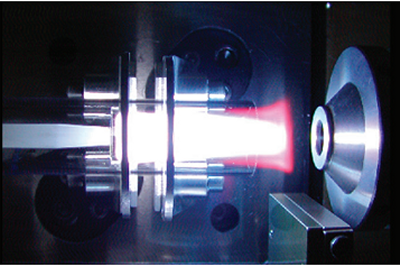
A plasma burns in an ICP instrument. Photograph courtesy of Perkin Elmer.
ST. MARY’S CITY, Md.—The word “plasma” brings images of TVs into the minds of most people. Chemists, however, think of powerful analytical instruments used to measure the amounts of trace elements in materials. Thanks to the Educational Partnership Agreement between the Naval Air Warfare Center Aircraft Division (NAWCAD) and St. Mary’s College of Maryland, the college’s Department of Chemistry and Biochemistry recently received by donation an inductively coupled plasma optical emission spectrometer (ICP-OES) from the Navy.
Dr. Geoff Eldridge, chemistry team lead in the Propulsion and Power Department at NAWCAD, arranged for the donation of the ICP-OES instrument to strengthen the partnership with St. Mary’s College. “The American Chemical Society recommends that this instrumentation be part of an undergraduate curriculum. This ICP-OES provides St. Mary’s College students experience with the technology, while providing NAWCAD backup capability in the case that the primary instrument at Patuxent River is out of service,” said Eldridge.
Eldridge was on hand for the donation ceremony and provided instruction for the students’ first laboratory experience with the ICP-OES, in which they measured the trace metal content of various water samples and sports drinks.
An ICP-OES measures the amount of virtually any metal in a sample. The instrument burns a small amount of sample in the high temperature plasma and measures the amount of light given off during this process. Every element produces light at specific wavelengths through this process, which lets the user determine which elements were in the sample.
While NAWCAD used the ICP-OES to measure trace metal content in jet fuels and engine lubricants, at St. Mary’s College the instrument will be used in multiple courses and in undergraduate research projects.
“This instrument greatly enhances our ability to provide students with hands-on educational experiences as well as new research opportunities,” said St. Mary’s College Chemistry Department Chair and Associate Professor Randolph Larsen. This spring semester students of Larsen’s chemistry class are using the instrument to measure levels of lead in contaminated soil.
In 2011, St. Mary’s College, NAWCAD, and The Patuxent Partnership formalized the Educational Partnership Agreement to advance scientific research and foster academic growth in science, technology, engineering, and mathematics (STEM). To date, the agreement has led to several external research grants and contracts which support student internships and research equipment.


